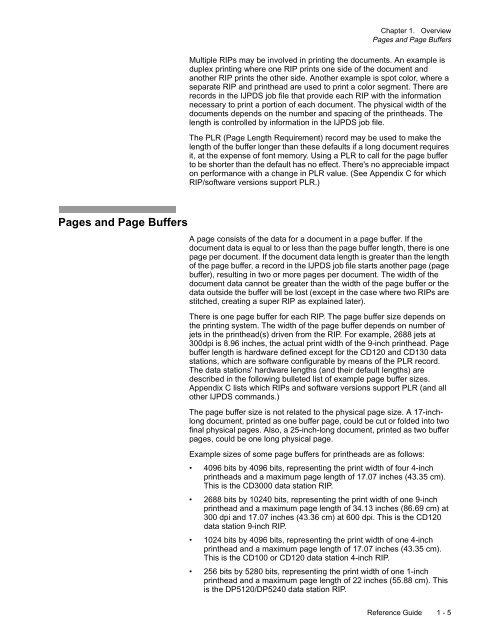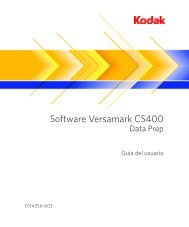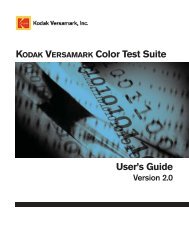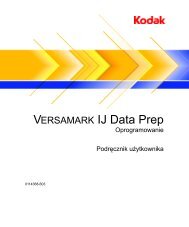Create successful ePaper yourself
Turn your PDF publications into a flip-book with our unique Google optimized e-Paper software.
Pages and Page Buffers<br />
Chapter 1. Overview<br />
Pages and Page Buffers<br />
Multiple RIPs may be involved in printing the documents. An example is<br />
duplex printing where one RIP prints one side of the document and<br />
another RIP prints the other side. Another example is spot color, where a<br />
separate RIP and printhead are used to print a color segment. There are<br />
records in the IJPDS job file that provide each RIP with the information<br />
necessary to print a portion of each document. The physical width of the<br />
documents depends on the number and spacing of the printheads. The<br />
length is controlled by information in the IJPDS job file.<br />
The PLR (Page Length Requirement) record may be used to make the<br />
length of the buffer longer than these defaults if a long document requires<br />
it, at the expense of font memory. Using a PLR to call for the page buffer<br />
to be shorter than the default has no effect. There's no appreciable impact<br />
on performance with a change in PLR value. (See Appendix C for which<br />
RIP/software versions support PLR.)<br />
A page consists of the data for a document in a page buffer. If the<br />
document data is equal to or less than the page buffer length, there is one<br />
page per document. If the document data length is greater than the length<br />
of the page buffer, a record in the IJPDS job file starts another page (page<br />
buffer), resulting in two or more pages per document. The width of the<br />
document data cannot be greater than the width of the page buffer or the<br />
data outside the buffer will be lost (except in the case where two RIPs are<br />
stitched, creating a super RIP as explained later).<br />
There is one page buffer for each RIP. The page buffer size depends on<br />
the printing system. The width of the page buffer depends on number of<br />
jets in the printhead(s) driven from the RIP. For example, 2688 jets at<br />
300dpi is 8.96 inches, the actual print width of the 9-inch printhead. Page<br />
buffer length is hardware defined except for the CD120 and CD130 data<br />
stations, which are software configurable by means of the PLR record.<br />
The data stations' hardware lengths (and their default lengths) are<br />
described in the following bulleted list of example page buffer sizes.<br />
Appendix C lists which RIPs and software versions support PLR (and all<br />
other IJPDS commands.)<br />
The page buffer size is not related to the physical page size. A 17-inchlong<br />
document, printed as one buffer page, could be cut or folded into two<br />
final physical pages. Also, a 25-inch-long document, printed as two buffer<br />
pages, could be one long physical page.<br />
Example sizes of some page buffers for printheads are as follows:<br />
4096 bits by 4096 bits, representing the print width of four 4-inch<br />
printheads and a maximum page length of 17.07 inches (43.35 cm).<br />
This is the CD3000 data station RIP.<br />
2688 bits by 10240 bits, representing the print width of one 9-inch<br />
printhead and a maximum page length of 34.13 inches (86.69 cm) at<br />
300 dpi and 17.07 inches (43.36 cm) at 600 dpi. This is the CD120<br />
data station 9-inch RIP.<br />
1024 bits by 4096 bits, representing the print width of one 4-inch<br />
printhead and a maximum page length of 17.07 inches (43.35 cm).<br />
This is the CD100 or CD120 data station 4-inch RIP.<br />
256 bits by 5280 bits, representing the print width of one 1-inch<br />
printhead and a maximum page length of 22 inches (55.88 cm). This<br />
is the DP5120/DP5240 data station RIP.<br />
Reference Guide 1 - 5

















